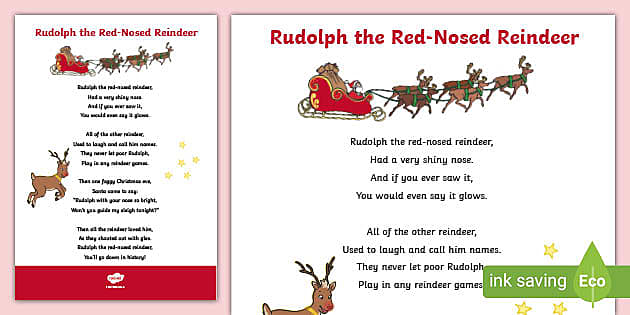Movie News
When Was Rudolph the Red Nosed Reindeer Song Written?
“Rudolph the Red-Nosed Reindeer” is one of the most iconic Christmas songs of all time, evoking warm memories of holiday cheer, childhood wonder, and festive celebrations. The story of Rudolph, the reindeer with a glowing red nose, has been beloved by generations, largely thanks to the catchy and heartwarming song that brought the tale to life. But when was Rudolph the Red Nosed Reindeer song written, and how did it become a beloved Christmas classic? Let’s Alibaytoon Store delve into the history of the song, its origins, and how it became a cultural phenomenon.

When Was Rudolph the Red Nosed Reindeer Song Written? The Origins of Rudolph’s Story
Before we dive into the song’s creation, it’s important to understand where the story of Rudolph the Red-Nosed Reindeer first originated. Rudolph wasn’t always a part of Christmas folklore. In fact, his journey started in the world of advertising.

In 1939, Robert L. May, a copywriter for Montgomery Ward, a department store in the United States, was tasked with creating a Christmas story that the store could give away to children as a promotional holiday booklet. May’s creation was none other than Rudolph the Red-Nosed Reindeer, a lovable misfit who, despite being different, played a key role in saving Christmas. The story of Rudolph quickly became a hit, with more than two million copies distributed by the store over the following years.
The Transition from Story to Song
Although Rudolph’s tale started as a promotional book, it was May’s brother-in-law, Johnny Marks, who transformed the story into the beloved Christmas song we know today. Marks was a songwriter and composer, with a special knack for creating holiday tunes. When he read May’s story, he immediately recognized the potential for a song adaptation. His vision would soon bring Rudolph’s story to an even wider audience.

In 1949, Marks began working on the lyrics and melody for “Rudolph the Red-Nosed Reindeer.” While the story was already familiar to many, Marks sought to create a song that would capture the heart of the tale, focusing on Rudolph’s uniqueness, his eventual triumph, and the lesson of accepting differences.
Marks wrote the song with the idea of turning Rudolph into a universal Christmas symbol—someone who, despite facing rejection, rises above adversity and is embraced for his individuality. This core message, combined with a catchy and cheerful tune, made the song an instant hit. But it wasn’t until a famous recording artist got involved that “Rudolph the Red-Nosed Reindeer” became a nationwide phenomenon.
The Year the Song Was Written: 1949
To answer the central question, when was “Rudolph the Red-Nosed Reindeer” song written? The song was penned by Johnny Marks in 1949. Marks composed both the lyrics and the music, ensuring that the melody was as memorable as the lyrics. His background in songwriting made him the perfect person to turn his brother-in-law’s story into a timeless song.
Gene Autry and the Song’s Rise to Fame
The final piece in the puzzle of Rudolph’s musical success came in 1949, when country singer Gene Autry was approached to record the song. Autry, already a well-known figure in both the music and film industries, was initially hesitant to record the song. However, his wife encouraged him to take a chance on it, sensing that the tune had the potential to become a Christmas hit.
In November 1949, Autry recorded the song, and it was released as a single just in time for the holiday season. His rendition of “Rudolph the Red-Nosed Reindeer” quickly gained popularity and became a massive success. By Christmas 1949, the song had topped the charts, reaching No. 1 on the U.S. Billboard charts in 1950. It sold over 2.5 million copies that first year alone, establishing itself as one of the most successful Christmas songs of all time.
Why Did “Rudolph the Red-Nosed Reindeer” Become So Popular?
The song’s success can be attributed to a combination of factors, including its catchy tune, relatable message, and the sheer talent of its creators. At its core, the song tells a story that resonates with people of all ages. Rudolph’s journey from rejection to acceptance, and the idea that everyone has something special to offer, strikes a chord with listeners during the Christmas season.
Additionally, the song is easy to sing along to, with its simple yet memorable melody making it perfect for children and adults alike. The imagery of the North Pole, Santa’s sleigh, and the other reindeer also helps to create a sense of wonder and magic, reinforcing its status as a holiday classic.
Gene Autry’s warm, engaging voice added a layer of sincerity to the song, making it feel personal and heartfelt. As one of the earliest country music stars to cross over into mainstream success, Autry’s recording introduced the song to a wide audience beyond traditional Christmas music listeners.
The Enduring Legacy of “Rudolph the Red-Nosed Reindeer”
Since its debut in 1949, “Rudolph the Red-Nosed Reindeer” has become a permanent fixture in Christmas celebrations worldwide. The song has been recorded by countless artists over the years, with notable versions by performers like Bing Crosby, Dean Martin, and Burl Ives. It has been translated into multiple languages, ensuring that the story of Rudolph reaches audiences across the globe.
The song’s success also paved the way for further adaptations of the Rudolph story. In 1964, a stop-motion animated television special titled “Rudolph the Red-Nosed Reindeer” aired on NBC, further cementing Rudolph’s place in holiday lore. The TV special, which featured songs written by Johnny Marks, remains a holiday staple to this day, airing annually during the Christmas season.
In addition to music and television, Rudolph has appeared in various forms of media, including movies, books, and merchandise. His image has become synonymous with Christmas, and the song continues to be one of the most-played holiday tunes each year.
Rudolph’s Message: A Timeless Lesson
One reason the song remains relevant today is its universal message. Rudolph’s story reminds us of the importance of accepting others for their differences and finding strength in what makes us unique. The song speaks to the value of kindness, empathy, and the idea that everyone has something special to contribute, no matter how different they may seem.
For children, the song teaches lessons about inclusion and self-confidence, showing that being different is not something to be ashamed of. For adults, it evokes a sense of nostalgia and hope, reminding us of the magic of Christmas and the power of community and togetherness.
The Cultural Impact of “Rudolph the Red-Nosed Reindeer”
Beyond its place in Christmas music, “Rudolph the Red-Nosed Reindeer” has had a profound impact on popular culture. The character of Rudolph has become a symbol of the holiday season, appearing in advertisements, decorations, and even charitable events. His image is often used to promote inclusivity and generosity during the holidays, and his story continues to inspire new generations.
Johnny Marks, who passed away in 1985, left behind a legacy of holiday music, with “Rudolph the Red-Nosed Reindeer” being his most famous work. His ability to craft a song that not only entertained but also taught valuable life lessons has ensured that his contribution to Christmas music will never be forgotten.
The song “Rudolph the Red-Nosed Reindeer” was written in 1949 by Johnny Marks and has since become one of the most beloved and enduring Christmas songs in history. From its humble beginnings as a story created for a department store’s holiday promotion, to its rise to fame through Gene Autry’s iconic recording, Rudolph’s tale of triumph and acceptance has resonated with listeners for over seven decades.
As we continue to sing about Rudolph’s glowing nose each holiday season, we are reminded of the timeless messages of love, inclusion, and the power of believing in oneself. The song’s enduring popularity ensures that Rudolph will continue to guide Santa’s sleigh—and our hearts—through many more Christmases to come.
Ready to celebrate the holidays in style? Get your Rudolph the Red-Nosed Reindeer T-shirts at Alibaytoon Store and spread the festive cheer!
